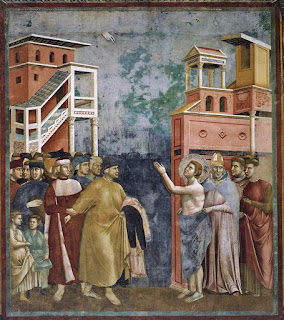Narrative Art:
Telling Tales About Art Practice; part 1
Narrative Art; Pre- Modern
A narrative is simply a
story (Tate, 2018a) and narrative art practice produces art and design work that
tells a story. Much of Western art until the twentieth century has been
narrative, depicting stories from religion, myth and legend, history and
literature. Audiences were assumed to be familiar with the stories in question.
A good example of this is the life of St Francis depicted in
the Basilica San Francisco, Assisi by Giotto 1300. Prior to the advent of
literacy most narrative art was done in a simultaneous narrative style with
very little overarching organisation. Once literacy developed in different
parts of the world pictures began to be organised along register lines, like
lines on a page that helped define the direction of the narrative.
Modern Narrative art
The Modern era in art is generally taken to begin around
1860 to 1960. Beginning with Manet’s Olympia, depicting a nude with frank
outward gaze, meeting the eye of the viewer and her unashamed nakedness and
wealth, "only the precautions taken by the
administration prevented the painting being punctured and torn" by
offended viewers (Neret, 2003) and encompassing mostly European and American
art ‘isms’ many of which are familiar to the casual art gallery goer; impressionism,
cubism, Russian Constructivism to name but a few (handy book …Isms, Little, 2004). In Modern art, formalist ideas have resulted in narrative being
frowned upon (Tate 2018a). This is circumnavigated by the use of coded
references to political or social issues.
These abstractions such as Picassos
Guernica 1937 are effectively modern allegories and generally require
information from the artist to be fully understood. To the downfall and end of Modernism, a grey area of disputed
times and finish dates, but around about the fruition of Andy Warhol’s ‘Factory’
opened in 1962 and the emergence of Pop Art. Modernism, around 100 years of
intense artistic transformation and global renewal, politically, industrially
and psychologically in the post war years.
Post Modern Narrative in Art
Practice
This led directly onto Postmodernism,
again debatable but around 1960’s to 1980’s. The Tate (2018b) writes that
Postmodernism defies explanation or definition but it definitely circumscribes changes
and challenges to Modernist art practice. It goes further, delineating the
underpinnings of Po-Mo art practice as drawing on philosophy of the mid to late twentieth century and advocating ‘individual
experience was more concrete than abstract principles’ (Cindy Sherman,
Film Stills) as well as inquiry into process and concept, and themes such as minimalism,
feminist art practice and land art.
Altermodern Neo Narrative
We are well past that time
and almost forty years seems an improbably long time ago (when it feels like
yesterday). Many critics call this era ‘Contemporary Art’ period, but there are
always new ideas and an alternative modernity is being posited by critic
and curator Nicolas Bourriaud (1998). Postmodernism, he suggests, is at an
end, to be replaced by a still-evolving successor, the Altermodern. A time
and an art practice that explores the bonds between; text and image, time and
space, and how they weave between themselves. This all takes place within a global
art community that previous, western-centric art movements lacked. Stories and
narrational formats in this Altermodern world are gathered from various sources
of cultural production in support of fictional drive: songs; newspaper reports;
advertising slogans (such as Jenny Holzer); quotations and onomatopoeiac 'sound
effects' are all used to illustrate, expand and sustain story-line.
Neo-narration Brannon (2009) says, marks a new phase of
artistic exploration, exploring cultural history, story-telling and the human
condition as a rich source of reference. The Altermodern also embraces
Relational Aesthetics, (Bourriaud 1998) art based on, or inspired by, human relations and
their social context. Bourriaud describes it as a set of artistic practices ‘which
take as their theoretical and practical point of departure the whole of human
relations and their social context, rather than an independent and private
space. E.g. Gillian Wearing, telling stories of people.’
There are stories in art and then there is Neo-Narration,
new stories in art and this is just a wander around the question of practice in
post-Post-modernity for artists and designers, making a virtual time line from
the intrinsic notion of narrative in pre Modern art, to its antithesis in
Modernism all fragmentation and cubist geometries – anti narration, to
Postmodernism with its ironic negativities, against Modernism, against
narrative, against taste. And now Altermodern, a whole new relational space for
art practitioners to tell their collective story.
Bourriaud, N., (1998) Relational
Aesthetics, Paris, Les Presse Du Reel.
Brennan, M, (2009), Neo-narration:
stories of art http://www.modernedition.com/art-articles/neo-narration/narrative-art-strategies.html accessed 8th February 2018.
Little, S., (2004) ...isms: Understanding Art,
New York, Universe Publishing.
Neret, G (2003). Manet. London, Taschen.
p. 22.
Tate (2018a) Narrative, http://www.tate.org.uk/art/art-terms/n/narrative, accessed 8th February 2018.
Tate, (2018b) Postmodernism, http://www.tate.org.uk/art/art-terms/p/postmodernism,
accessed 25 march 2018.







Comments
Post a Comment